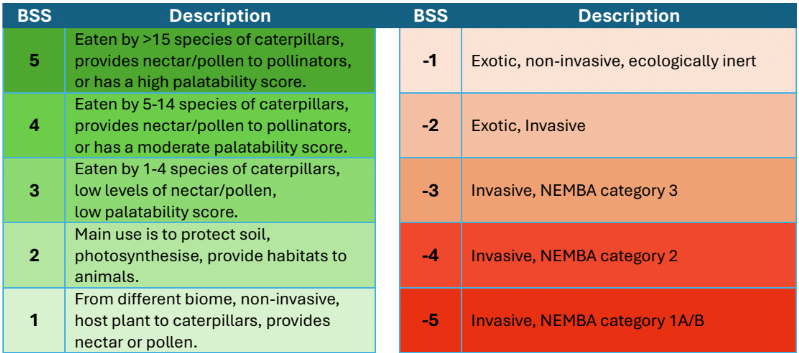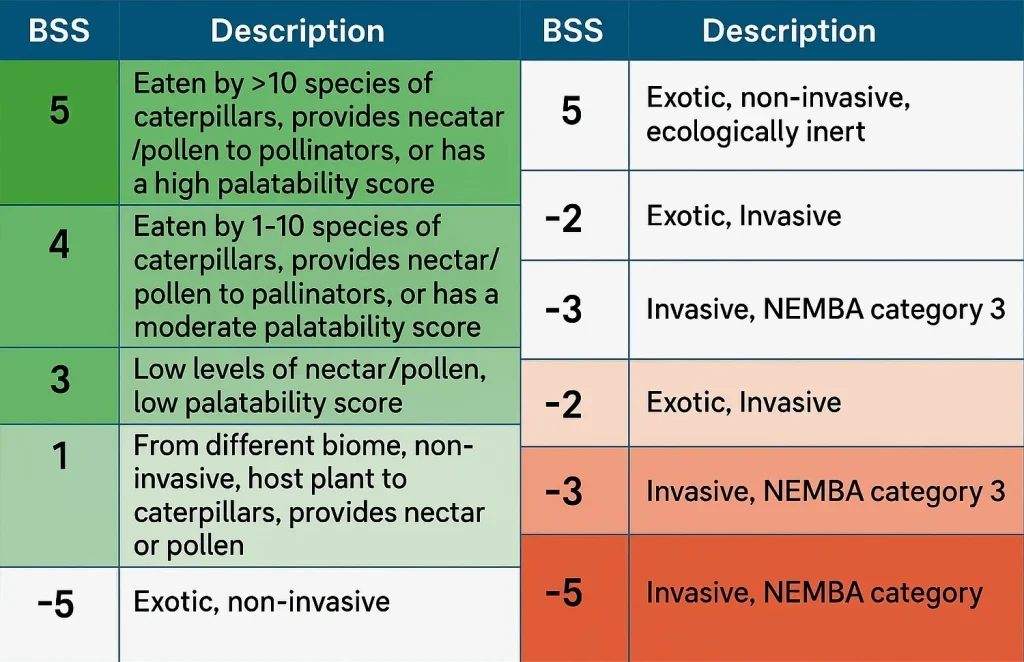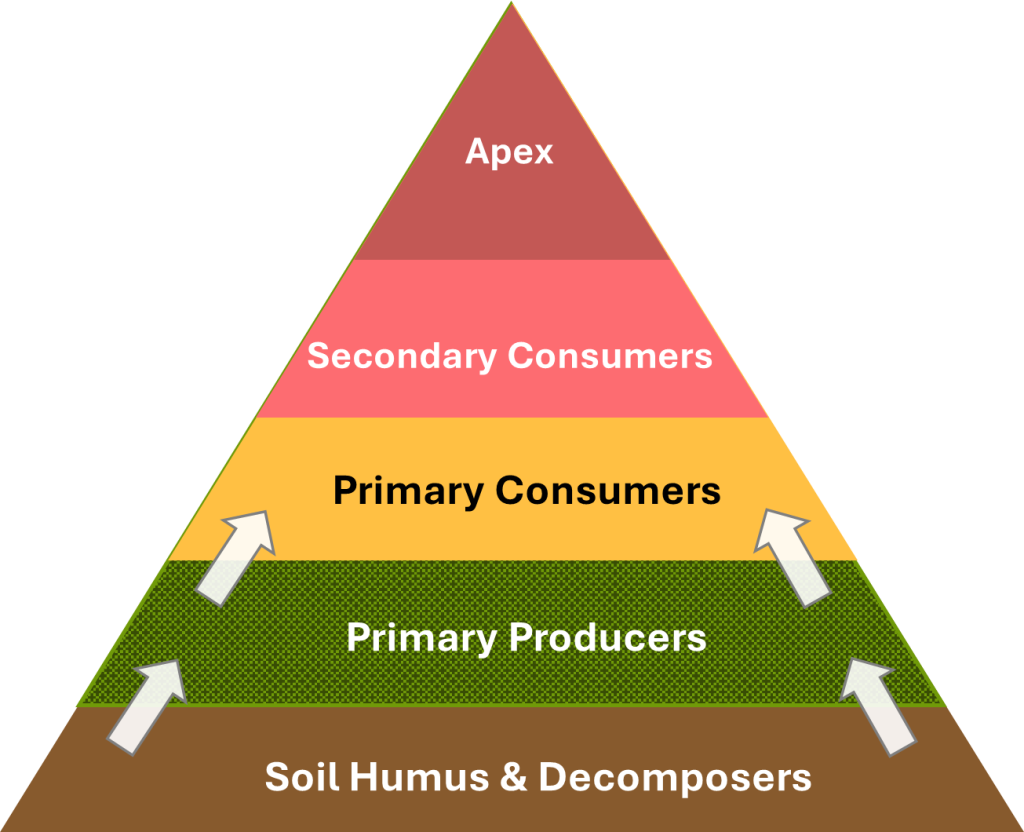Background
We can reverse a lot of the damage we have done, simply by planting the right plants.
Nature is the very foundation of our existence. Yet as humans, we are pushing the intricate balanceof life toward collapse. We have transformed ourlandscapes leaving behind fragmentedecosystems struggling to adapt.
To safeguard the future, we must learn to coexist with the natural world, no matter where we live.From urban areas to rural country sides,the fragments ofunused open space hold the potential tobecome a lifeline for biodiversity. Byplanting the right plants inopenspaces, we can createcorridors that connect fragmented habitats, enabling the flow of life through areas that were onceuntouched and vibrant.
Restoring nature is not justan ecological necessity—it is essential for ourwell-being,health,mental well-beingin addition to beinga moral responsibility. By nurturing open spaceswherever welive, we can renew the bonds between ourselves and the wild, ensuring that even amidsthumanprogress, biodiversity has room to thrive.
We can reverse a lot of the damage we have done, simply by planting the right plants.
We can reverse a lot of the damage we have done, simply by planting the right plants.
Nature is the very foundation of our existence. Yet as humans, we are pushing the intricate balance of life toward collapse. We have transformed our landscapes, leaving behind fragmented ecosystems struggling to adapt.
Read More...
To safeguard the future, we must learn to coexist with the natural world, no matter where we live. From urban areas to rural countryside, the fragments of unused open space hold the potential to become a lifeline for biodiversity. By planting the right plants in open spaces, we can create corridors that connect fragmented habitats, enabling the flow of life through areas that were once untouched and vibrant.
Restoring nature is not just an ecological necessity—it is essential for our well-being, health, and mental well-being in addition to being a moral responsibility. By nurturing open spaces wherever we live, we can renew the bonds between ourselves and the wild, ensuring that even amidst human progress, biodiversity has room to thrive.
Optimise your Impact on Restoring Biodiversity
Optimise your Impact on Restoring Biodiversity
Far fewer plants are eaten by animals than initially thought.
As the most advanced animal that has ever lived, even with the ability to increase the digestibility of food, we cannot thrive in wild spaces. We need to farm the limited edible plants for us to thrive. All animals can eat even fewer plants than we can eat. By removing their feed plants, we have basically starved most indigenous animals to extinction wherever we live, allowing pests such as rats and cockroaches to fill the niches once filled by a diversity of local animals
Read More...
We can restore the diversity of butterflies, birds and bees to our open spaces by planting for herbivorous insects and small mammals.
We have used all available data to categorise plants according to the ability of the plant to feed herbivores (See table). Plants indigenous to a biome have a positive Biodiversity Supporting Score(BSS) ranking from 1 to 5, depending on the number of herbivores that feed on the plant or flowers. Plants from a different biome within the region would have a score from 0-2. Exotic plants have a negative score, with the value indicating how invasive a plant is.
Definitions of Biodiversity Support Scores

Biodiversity Support Score
Biodiversity Support Score
To help guide your plant selection, available data has been analysed to categorise and score plants based on the number of herbivore species they support. Most of the data focuses on plants that are essential for caterpillars, pollinators, and mammalian herbivores, providing a clear framework for optimising biodiversity and ecosystem restoration efforts.
Biodiversity Support Score
Biodiversity Support Score
To help guide your plant selection, available data has been analysed to categorize and score plants based on the number of herbivore species they support. Most of the data focuses on plants that are essential for caterpillars, pollinators, and mammalian herbivores, providing a clear framework for optimizing biodiversity and ecosystem restoration efforts.

Why Insects
Why Insects
Insects are the largest and most diverse group of herbivores, both in numbers and biomass. This group includes caterpillars, grasshoppers, beetles, true bugs, grubs, maggots, and nectar-feeders like bees, butterflies, and flies. Each plays a unique and critical role in maintaining ecological balance and sustaining life on Earth.
Read More...
The absence of insects would trigger an ecological catastrophe. Without pollinators, our crops would fail. Without detritivores, soil fertility would decline, halting the growth of food, grasslands, and forests. Without prey species like caterpillars and grubs, entire food chains—from birds to apex predators—would collapse. Humanity’s very survival is deeply intertwined with that of insects, yet their populations are being devastated by habitat destruction, pesticide use, and climate change.
Insects are not just essential; they are irreplaceable. By protecting them and nurturing their habitats, we ensure the survival of countless other species, including our own. Their resilience has sustained ecosystems for millions of years—it is now our responsibility to give them the chance to sustain ours.
It’s time to rethink our priorities. Sterile, manicured gardens must give way to spaces designed to sustain nature, including beneficial insects. Gardening for biodiversity not only keeps life on Earth thriving but also brings the joy of seeing nature return. Open spaces and gardens easily become a haven for life, offering regular marvels—like dazzling butterflies, industrious bees, and new forms of life that sparkle like jewels.
Why Caterpillars?
Why Caterpillars?
Caterpillars are among nature’s most selective eaters. Caterpillars are among nature’s most selective eaters. The caterpillars of many butterfly and moth species are highly specialised feeders (monophagous or oligophagous), relying on just one or a few plant species for survival. This dependency makes them invaluable for guiding plant choices in ecosystem restoration.
Read More...
Think of it this way: hosting caterpillars is like hosting friends with very strict dietary requirements. If you serve food that caters to everyone’s tastes, even the pickiest eaters will be satisfied. However, if you only prepare meals for general preferences, those with strict needs will go hungry. Similarly, focusing on the specific plants that caterpillars need ensures that these specialists survive—and when they thrive, pollinators and generalist species will flourish as well.
By planting for the full range of butterflies and moths that naturally occur in an area, you create an environment where generalists and specialists alike can prosper. This selective feeding behaviour of caterpillars serves as a natural blueprint for rebuilding ecosystems that are inclusive and functional for all.
Nature’s Protein-Packed Power Snack!
Caterpillars aren’t just cute and squishy. They’re a vital cornerstone of many ecosystems. Among herbivorous invertebrates like slugs, snails, grubs, grasshoppers, and true bugs, caterpillars stand out as the ultimate snack for insect-eating animals. Why? They’re abundant, packed with nutrition, easy to catch, and soft and digestible. They are far more appealing than harder-bodied insects like beetles.
Caterpillars are nutrient powerhouses, offering essential building blocks for growth and development. Their nutritional makeup includes: Protein (50–70% of their dry weight), Fats (10–30%), Water (80–90%), Carbohydrates (Less than 10%), and key nutrients: Calcium, phosphorus, B vitamins (like B12), carotenoids, and amino acids like lysine and methionine.
Essentially, caterpillars are like nature’s multivitamin-energy bar combo, especially for young birds and small mammals needing a fast, nutritious meal.
Essentially, caterpillars are like nature’s multivitamin-energy bar combo, especially for young birds and small mammals needing a fast, nutritious meal.
But being such a popular food source comes with challenges. To survive the heavy predation by birds, bats, wasps, spiders, and other predators, caterpillars have developed a unique survival strategy: sheer numbers. Many moths and butterflies lay 200–1000 eggs, yet only 1–5% make it to adulthood. The rest, especially those without chemical defences or camouflage, provide vital nourishment for predators.
This reliance on caterpillars as an essential food source highlights their critical role in ecosystems. Protecting caterpillars means protecting the delicate balance that sustains biodiversity—and, in turn, our planet.
The Problem: Major Drivers of Ecosystem and Biodiversity Collapse
The Problem: Major Drivers of Ecosystem and Biodiversity Collapse
The intricate balance of ecosystems that flourished before the Industrial Revolution was perfected over millions of years, was shaped by the co-development of plants and animals. This symbiosis fostered a dazzling diversity of species, each uniquely adapted to and dependent on local flora. But this equilibrium began to unravel as humans colonized vast portions of the planet.
The Anthropocene brought sweeping changes. Humans have reshuffled plants and animals across the globe, introducing invasive species that outcompete native populations and wreak havoc on ecosystems. The delicate tapestry of nature has been torn apart, leaving fragmented habitats and disrupted biodiversity in its wake.
Read More...
Exponential growth in the human population: For most of human history, the human population grew slowly, held back by limited food, disease, and high mortality rates in hunter-gatherer and early farming societies. About 10,000 years ago, the agricultural revolution began nudging numbers upward, reaching around 300 million people by 1 CE. However, plagues and famines often kept growth in check—until the Industrial Revolution changed everything.

In the late 18th century, technological breakthroughs like mechanised farming and fertilisers, combined with medical advancements such as vaccines, antibiotics, and improved sanitation, dramatically reduced death rates. At the same time, food production soared. These changes sparked exponential population growth on a scale the planet had never seen.
But this explosion in human numbers has come with a cost. Agricultural lands and domestic animals like cattle and chickens have increased even more dramatically, dominating land and resources. As they expand, wild populations are squeezed into ever-smaller patches, driving up our ecological footprint and putting additional pressure on Earth’s fragile ecosystems.
Our consumerist, throwaway culture is expanding our ecological footprints to unprecedented levels. Coupled with the fast population growth, our impact on the planet is outpacing even this rapid growth. Urbanisation, industrialisation, and unsustainable farming practices are driving habitat destruction at a pace faster than species can adapt. Overharvesting is stripping ecosystems bare, plastic pollution clogs our landfills and rivers, and pesticides are poisoning our fields and contaminating wildlife, waterways, and soils alike.

The consequences are staggering: roughly 95% of Earth’s surface now bears the mark of human activity, with about 70% of it fundamentally altered by agriculture, urban expansion, and industrial development. In South Africa, only about 20% of the land remains protected as national parks, private reserves, or other conserved areas. These few remaining spaces are all that’s left of what can truly be called wild or natural.
Restoring Ecosystems from the Bottom Up
Restoring Ecosystems from the Bottom Up
The species-specific approach to conservation or ecosystem restoration has its merits, particularly in generating public support, securing funding, and raising awareness for conservation efforts. However, an ecosystem-based approach offers a broader and more sustainable solution by focusing on the health of entire systems.
Read More...
This method integrates plants, animals, soil, and water to build resilience. Central to this approach is the selection of plants that drive biodiversity, serving as the foundation of food webs and habitats. This bottom-up strategy is adaptable to a variety of landscapes, from urban green spaces to sustainable agricultural areas, restoring vast pieces of disturbed land to nature reserves.
Once exotic invasives have been controlled and soils achieve adequate microbial and microfauna activity, the next step is to select plants suited to the specific area and its intended land use. Plants with high biodiversity support scores act as biodiversity engines, greatly enhancing the potential for creating diverse and resilient ecosystems.

Steps to Restoring Ecosystems

1. Restore Soil Health
- Assess soil conditions, such as nutrient levels, pH, and microbial activity.
- If needed, add organic matter (e.g., compost, mulch, or leaf litter) to enrich nutrients and improve structure.
- Avoid use of harmful chemicals.

2. Prevent Runoff and Erosion
- Implement measures to reduce water runoff.
- Use ground-cover pioneer plants, nitrogen fixing legumes, and grasses to stabilize soil and prevent erosion.

3. Remove exotic invasive plants
- This is often the most challenging aspect of restoring biodiversity or rewilding a piece of land.
- Assess the severity of the plant invasion and match the effort and methods to the scale of the problem.
- Build in a plan for periodic assessment and control of regrowth of invasives.

4. Reintroduce high BSS plants
- Select plants adapted to the specific biome. Our tool will assist you select species that are suitable for your specific area that support biodiversity and food webs.
- Replicate natural layers in the ecosystem by planting a mix of different growth forms such as trees, shrubs, grasses, shrubs, and creepers, depending on the location of the site.

5. Monitor and Adapt
- Regularly monitor soil, water, and biodiversity health to track progress.
- Use scientific data and community input to refine restoration efforts.
- Use broad assessments to establish a baseline that can be used for diverse monitoring tools in years to come.
- Select your monitoring method and stick to it to enable you to measure the progress over time.
- Be prepared to adjust your approach based on ecosystem feedback.
Role of GRG and animal scientists
Role of GRG and animal scientists
The Datasets used to determine the Biodiversity Support Scores.
For decades, animal scientists, lepidopterists, and caterpillar rearers have meticulously gathered data, shaping our understanding of plant-herbivore interactions. More recently, the Caterpillar Rearing Group (CRG), a LepSoc Africa initiative led by Hermann Staude, has compiled an extensive dataset documenting the host plants of over 3,500 species of Lepidoptera reared across Africa by numerous enthusiasts.
Read More...
Building on the CRG’s findings, Lynn Katsoulis has integrated this dataset with multiple sources, incorporating plant distributions, ecological attributes, grazing value, large-herbivore interactions, and pollinator nectaring benefits. The result is a predictive system that assigns a biodiversity support score to listed plants, providing valuable guidance for biodiversity restoration efforts.
This dataset is a living resource that will be continuously updated as new discoveries emerge.
Your Observations Matter
Whether you’re a scientist, conservationist, or nature enthusiast, your contributions can help refine and expand this knowledge base. iNaturalist has become the leading platform for recording plant-animal interactions. If you observe a herbivore or pollinator interacting with a plant, upload clear images to ensure accurate identification of both species. If you discover a new caterpillar, consider rearing it; this process offers valuable insights into host plant associations and life cycles.
•For more information on the CRG, visit Caterpillar Rearing Group on iNaturalist
Make a Donation
Donate to Support ABERI
Banking Details
Bank Name: Capitec
Account Name: Business Account
Account Number: 1051 0584 65
The Problem
- It took an awfully long time for thenature to develop its intricatebalance that was in place beforethe industrial revolution
- Mankind was able to coexist withnature until our populations increased exponentially
- Our consumerist, disposableculture along with urbanization,industrialization, unsustainableagriculturalpractices, and the overextraction of natural resources has made each of ourecological footprintsfarbiggerthan ever before.
- The result is about95% of Earth’s surface shows some form of human modification, andabout 70% has been transformed,primarily through agriculture,urbanisation, and industrial development.Only about 20% ofSouth Africa’s land is considered wild or natural–includingnational parks, private reserves and other protected areas
- All animals have very restricted diets.Ecosystems require the rightplants for the indigenous animals for resilient food webs to form
- Exotic or invasive plants pose a significant threat to biodiversity.These plants disrupt ecosystems by outcompeting native species,altering habitats, and consuming vital resources like wate
- Insects are the largest group of herbivores, in terms of diversity and biomass. Theseinclude, caterpillars, root and foliage eating grubs, leaf miner and fruit fly maggots,grasshoppers, some beetles, true bugs, and manynectar feedinginsects such asbees,butterfliesandflies.Each of these groups interacts uniquely with ecosystems, contributingto energy flow, nutrient cycling, and plant population control
Restoring Ecosystems from the Bottom Up
Placeholder Text
Steps to Restoring Ecosystems
1. Restore Soil Health
- Assess soil conditions, such as nutrient levels, pH, and microbial activity.
- If needed, add organic matter (e.g., compost, mulch, or leaf litter) to enrich nutrients and improve structure.
- Minimise chemical use.
2. Prevent Runoff and Erosion
- Implement measures to reduce water runoff.
- Use ground-cover pioneer plants, nitrogen fixing legumes, and grasses to stabilize soil and prevent erosion.
3. Remove exotic invasive plants
- This is often the most challenging aspect of restoring biodiversity or rewilding a piece of land.
- Assess the severity of the plant invasion and match the effort to remove the plants to the scale of the problem.
4. Reintroduce Native Plant Species
- Select plants adapted to the specific biome. Our tool will assist you to select species that are suitable for your specific area that support biodiversity and food webs.
- Replicate natural layers in the ecosystem by planting a mix of different growth forms such as trees, shrubs, grasses, shrubs, and creepers, depending of the location of the site.
5. Reintroduce Native Plant Species
- Select plants adapted to the specific biome. Our tool will assist you to select species that are suitable for your specific area that support biodiversity and food webs.
- Replicate natural layers in the ecosystem by planting a mix of different growth forms such as trees, shrubs, grasses, shrubs, and creepers, depending of the location of the site.
6. Monitor and Adapt
- Regularly monitor soil, water, and biodiversity health to track progress.
- Use scientific data and community input to refine restoration efforts.
- Select your monitoring method, and stuck to it to enable you to measure the progress over time.
- Be prepared to make adjustments based on ecosystem feedback.
